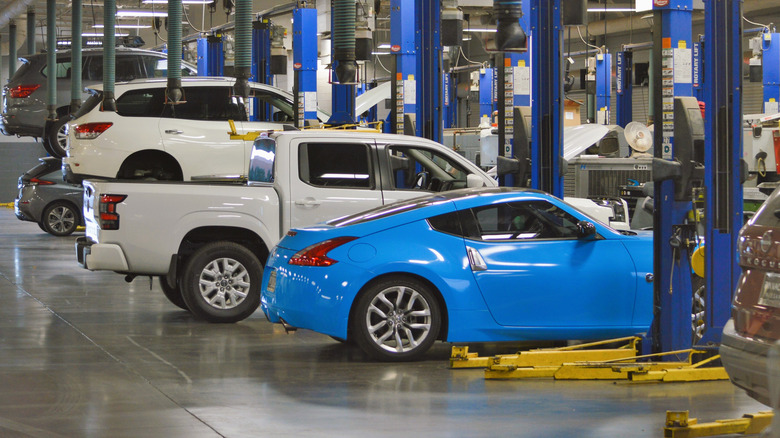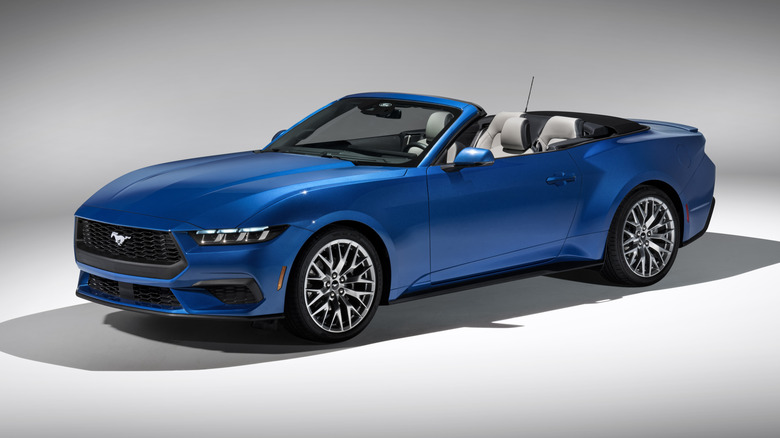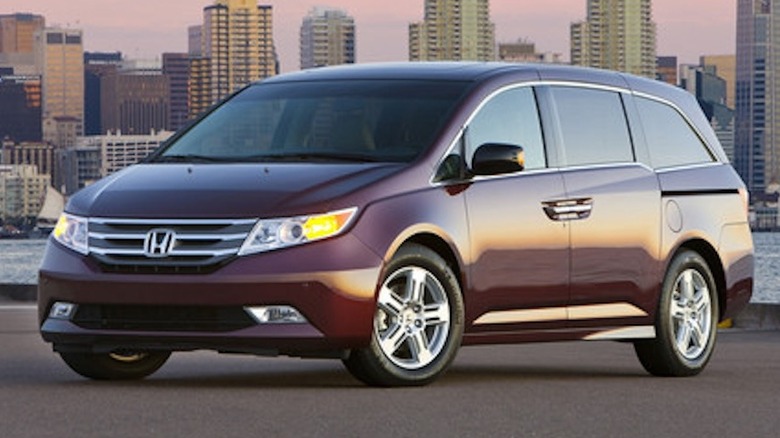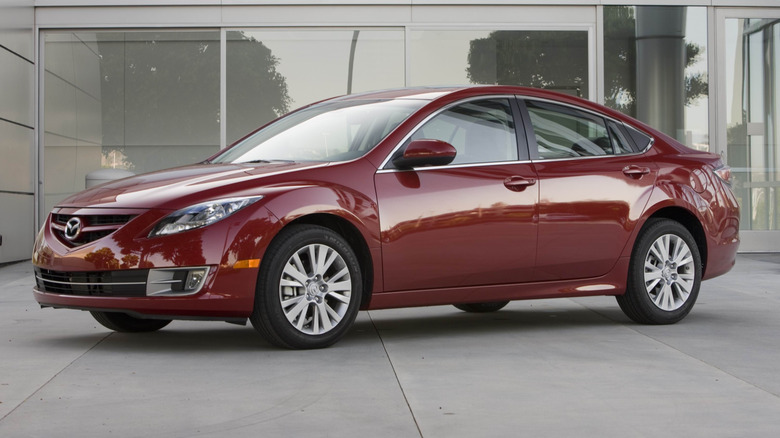9 Of The Most Absurd Car Recalls In Automotive History
If you own, have owned, or know someone who owns or has owned a car or truck, you know about recalls. It's fairly common these days for manufacturers to ask owners to bring their vehicles in for complimentary servicing due to something being prone to problems. Sometimes it's caused by the mundane, sometimes the problem is extremely dangerous, and sometimes the situation is just plain bizarre.
That's what we're looking at today: Nine examples of some of the weirdest automotive recalls we could dig up. Despite what you might think, the list isn't entirely made up of all the same car brands with the most recalls, because it's not about volume. It's about that "Wait... what?" factor.
To that end, this list has been organized from least strange to most odd, with a mixture of what actually makes the recall eye-brow raising sprinkled in for good measure. Maybe it's because of the slightly comical nature of the problem. Maybe it's due to the number of vehicles being recalled. Maybe it's because of spiders. Spiders came up a lot more than expected, actually.
General Motors motor mount recall
Our first entry is something of a doozy, with a 1971 General Motors recall of 6.7 million Chevrolet and GMC vehicles due to a simple but rather catastrophic defect. However, the company initially insisted was not actually a safety defect so much as overblown public worry caused by "misinformation and misunderstanding," according to statement provided to The New York Times.
Said non-issue? Failing motor mounts, which are used to absorb engine vibrations so they don't pass into the vehicle's frame. According to reports from multiple owners at the time, the mounts would break and cause the engine to come loose.
That may not sound too bad, but the real problem is that the engine would often shift several inches within the engine compartment. This would result in a very bad combination of the throttle jamming open while also damaging the power brake lines. In other words, many of the affected vehicles would begin to accelerate uncontrollably with no functional brakes. It almost reads like a convoluted murder plot from a spy movie.
Fortunately, after several years of customer complaints and a Federal investigation, the National Highway Traffic Safety Administration (NHTSA) eventually posted a consumer protection bulletin about the problem. This — along with the publicity brought to the issue by future presidential candidate Ralph Nader — was able to help convince General Motors to issue a voluntary recall, whereupon the company did fix the very clear safety concern by basically tying the engine down so that it wouldn't move if or when the motor mounts broke.
Ford transmission recall
GM wasn't (and isn't) the only automotive manufacturer to push back against allegations of defective parts, or warnings from the U.S. government about those reported issues. Ford transmission failures were a similar problem back in 1980, resulting in a recommended recall of over 16 million Ford cars and trucks produced from '72 to '79 — one of the biggest transmission recalls of all time.
Once again the NHTSA had to get involved, reporting some 23,000 driver complaints and nearly 100 deaths as the result of a design flaw in the automatic transmission system. For its part, Ford claimed that the failure rate of its automatic transmission was no different than any other automotive manufacturer at the time, but this wasn't a simple matter of the transmission failing or locking up.
What was actually happening is that drivers would put their vehicles into park, but the system would switch into reverse of its own accord. At best it would be irritating to have park simply not work as intended, but the NHTSA suggested that a much more dangerous scenario was far more common. One in which the driver would park, their passenger would get out, then the car would lurch backwards unexpectedly — possibly slamming into passengers or other pedestrians that were walking behind it.
Ford transmission recall — again
The worst part about Ford's transmission troubles from back in the 1970s and '80s is that we get to relive history roughly 45 years later. A March, 2025 recall on some 2024 and 2025 models of Aviator, Bronco, Explorer, F-150, Mustang, and Ranger vehicles cites, you guessed it, "unexpected vehicle movement" as the primary cause, as described in the official NHSTA recall notice.
It's not quite as extensive as that more infamous 1980 recall — in this instance only affecting approximately 269 vehicles instead of tens of millions — but it's still eerily similar. Now, though, the problem seems to be an incorrectly-machined valve body causing affected models to move forward unexpectedly when put into park or reverse. That, or the reverse gear will fail outright.
Yes, this recall is practically the modern equivalent of the previous entry — if inverted — and it does involve the same entities as last time. Still, as the saying goes, "It's not a lot, but it's weird that it happened twice."
Subaru key fob recall
The protestations of seemingly sentient vehicles doesn't stop with random acceleration (and brake failure) or deciding you chose the wrong gear, though. A 2013 Subaru recall ended up happening because some 47,000 vehicles — specifically 2010 to 2013 models of Impreza, Legacy, Outback, and XV Crosstrek — had a tendency to turn their engines on without their owners' knowledge.
Now this isn't to say it was a proper vehicular uprising, although the NHTSA has had its eyes on Tesla's autopilot lately. In this case the culprit was actually the remote starter built into the key fob. However, not every Subaru key fob with a self starter was at risk. Specifically it was the Audiovox starter that was paired with automatic transmissions built around 2010 to 2013.
The affected fobs had a tendency to send a start signal to their paired vehicles when dropped. Since key dropping is fairly common among most humans, and can often happen indoors as we put our keys away, take them out, or simply move them for whatever reason, owners wouldn't always realize that their engine was unexpectedly running.
There was no automatic cutoff for this self starting system, either, so the engine would just run, and run, and run. It would continue to do so until either customers realized what was happening and turned them off again, the key fob's battery died, or the vehicle burned through all the gas in its fuel tank.
Volkswagen car seat fire risk recall
Car fires are no laughing matter, but what's arguably even more alarming than an engine bursting into flames is having the driver's seat combust. While you're sitting in it. A very dangerous Volkswagen defect, to be sure.
Malfunctioning seat heaters lead to very intense and focused rapid rises in temperature, at best leading to discomfort and distraction while driving. At worst, this can lead to an actual fire. Affected models included 2002 to 2004 Golf, Golf GTI, and Jetta, except using past tense here isn't entirely accurate. Despite the issue cropping up in vehicles from the early '00s — plus an even older recall for some 1990 to 1997 built Volkswagens — a lot of the affected cars haven't been serviced.
Dangerous seat heater breakdowns aren't exclusive to Volkswagen, of course. However, what makes this particular example such a big problem — other than the potential to literally set your pants on fire — is because there are still Jettas, GTIs, and Golfs out there that could burn second- or even third-hand owners. Since the recall happened back in 2007, there's also the chance that Volkswagen will decline to cover repairs due to the being outside of the recall window and well past the vehicle's warranty.
Honda badge recall
Now we really start getting into the weeds of absurdity. Also, we get to talk about the only entry on this list that isn't some kind of safety risk — though has a different kind of significance. This 2013 Honda Odyssey recall had nothing to do with faulty components or dangerous design oversights. It was actually purely cosmetic. Somehow, several Odysseys managed to make their way to market with badge errors. As in, the Honda logo badge wasn't applied correctly.
Some of the badges were crooked, some were installed on the wrong side of the rear of the car, and in some instances the badge wasn't installed at all. Fortunately it was an easy fix, which Honda accommodated without any fuss, and posed no risk to drivers, passengers, or pedestrians. It could, however, have put a damper on aftermarket sales.
As mundane as a skewed or absent manufacturer logo may seem in the grand scheme of things, it does matter when it comes to reselling a car later on. Potential buyers could see it as an indication of a previously undisclosed accident with possible hidden issues that would need repairs or question the car's authenticity outright. Of course, debadging isn't entirely unheard of either, with some drivers opting to take the logos off for cosmetic reasons. People have even been known to steal Volkswagen badges — although no one is quite sure why.
Toyota spider recall
The more complex technology gets, the more often we'll encounter glitches and errors with unintended side effects. This could be from fancy software in need of an update so it works properly — but sometimes these bugs can be literal, too. That's why what happened with this 2013 Toyota recall sounds like the stuff of nightmares. Over 870,000 vehicles (2012 and 2013 Avalons, Camrys, and Venzas) were flagged for servicing because of an abundance of spiders — seriously.
However, it wasn't an infestation so much as an unintentional design choice creating a very enticing environment for nature's little exterminators to settle in. Now, spiders setting up shop inside a car isn't unheard of, but in this case their webs had a tendency to block a drainage tube for the vehicle's air conditioner condenser. That would sometimes result in water building up and causing a short in the airbag control module.
At best, this meant the airbag warning light would come on for seemingly no reason, prompting what was likely a very confusing trip to a repair center. At worst, though, the short could cause the airbag to deploy on its own, at random. Like having a ticking time bomb sitting in front of the driver's face without them realizing it. A small fix that prevented water buildup from reaching the airbag module was all it took, thankfully.
Mazda spider recall — again
Oh, but we're not done with spiders yet — although it might be more accurate to say the spiders aren't done with us. Mazda had to issue two separate recalls (in 2011 and 2014) for 2009 to 2012 model Mazda 6s because they attracted spiders. Specifically the yellow sac spider, which is very common in the U.S. and may actually be the species that bites the most humans.
Not that biting is anything Mazda 6 owners need to worry about, really. It was the car's evaporative canister vent lines that were the target, as they made an ideal nesting spot due to the tube shape — which resembled the species' preferred home foundation — and the fact that they smelled like gas. Spiders use hydrocarbons, which gasoline is, as scent markers.
So really, how could these yellow sac spiders pass up the opportunity? It's ideal (and free) real estate! Problem is, those nests would block the vent lines and the pressure build up could crack the car's fuel tank.
Mazda's initial approach for its 2011 recall was to install a spring in the vent lines to discourage any spiders from moving in, but it seemingly didn't quite get the job done because a re-recall was necessary again in 2014. This time Mazda gave up on trying to keep the spiders out, and instead adjusted the car's software so that a tube blockage wouldn't lead to a pressure build up. Let this be a lesson — spiders always win.
Koenigsegg tire pressure recall
You'd think spiders would be as weird as car recalls get, and if someone else were to make a similar list that could even be the case, but as far as I'm concerned, the Koenigsegg Agera takes the top spot. Here, it's not that a weird problem led to a recall, it's that a fairly mundane problem resulted in a very odd recall.
The 2013 Koenigsegg Agera made it out of the factory and onto the market with a tire pressure monitoring problem. Said problem would have potentially prevented the tire pressure warning light from turning on, which could have resulted in the tire pressure falling low enough to cause a crash.
Fixing it was a simple matter of updating the software so that the error would no longer occur. Easy peasy, right? Except this wasn't a recall for a few thousand, a few hundred thousand, or even millions of vehicles. It was one. Just one car. One $1.5 million supercar that, at least at the time, was only sitting in one person's garage.









